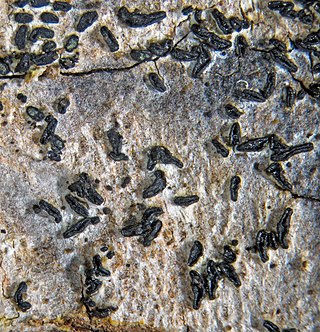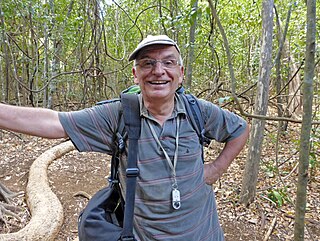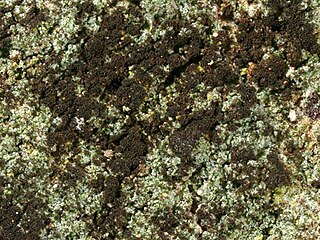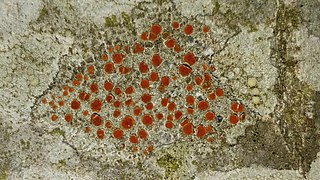
Micarea is a genus of lichenized fungi in the family Pilocarpaceae. The widely distributed genus contains 126 species and new species are described actively. Species in the genus are crustose lichens and their photobiont is a single-celled green alga.

Enterographa is a genus of lichens in the family Roccellaceae.

Opegrapha is a genus of lichenized fungi in the family Opegraphaceae. Species include:

Syncesia is a genus of lichen-forming fungi in the family Roccellaceae.

Nyungwea is a genus of lichen-forming fungi in the family Opegraphaceae. It was circumscribed in 2006 by Emmanuël Sérusiaux, Eberhard Fischer, and Dorothee Killmann, with Nyungwea pallida assigned as the type species.
Synarthonia is a genus of lichen-forming fungi in the order Arthoniales. The genus has not been placed into a family. Synarthonia was circumscribed by Swiss lichenologist Johannes Müller Argoviensis in 1891.
André Aptroot is a Dutch mycologist and lichenologist.
Coccocarpia delicatula is a species of foliicolous (leaf-dwelling) foliose lichen in the family Coccocarpiaceae. Known only from the Galápagos Islands and Réunion, it was described as new to science in 2011. Characterised by its rounded, foliose thallus and unique cylindrical isidia, this lichen is similar in appearance to Coccocarpia domingensis but has distinct differences in isidia shape and arrangement. Found on the bark and wood of dead twigs, Coccocarpia delicatula thrives in sunny, wind- and rain-exposed environments.

Alyxoria is a genus of lichen-forming fungi in the family Lecanographaceae.

Emmanuël Sérusiaux is a Belgian lichenologist. His career, spanning more than four decades, has combined both lichenology research and political aspects of nature conservation. He spent several periods working as a researcher at the National Fund for Scientific Research and the University of Liège, the latter in which he accepted a faculty position as professor and head of the Plant Taxonomy and Conservation Biology unit. Sérusiaux also served for three non-consecutive appointments as Deputy Chief of Staff in the Government of Wallonia. He retired from both his academic and political positions in 2019.
Synarthonia leproidica is a species of saxicolous (rock-dwelling) and crustose lichen in the order Arthoniales. Found in Luxembourg, it was formally described as a new species in 2020 by lichenologists Damien Ertz, André Aptroot, and Paul Diederich. The type specimen was collected in the Vallée du Lellgerbaach (Lellingen) at an elevation of 323 m (1,060 ft). Here the lichen was found on a siliceous wall at the edge of a forest path in an oak-hornbeam forest. It has a pale greyish crust-like thallus with dark brown/violet tinges. It has a leproid growth form, meaning that it looks like it is made of granules; the specific epithet refers to this characteristic. The thallus forms patches that are about 0.5–5 mm in diameter, although neighbouring patches can coalesce to form larger patches up to 10 cm (4 in) in diameter. Synarthonia leproidica contains psoromic acid, a secondary chemical that can be detected with thin-layer chromatography.
Henricus (Harrie) Johannes Maria Sipman is a Dutch lichenologist. He specialises in tropical and subtropical lichens, and has authored or co-authored more than 250 scientific publications. He was the curator of the lichen herbarium at the Berlin Botanical Garden and Botanical Museum from 1983 until his retirement in 2010.

Candelaria pacifica is a widely distributed corticolous (bark-dwelling), leprose lichen. It was formally described as a species in 2011.

Reichlingia is a genus of lichen-forming fungi in the family Arthoniaceae. It has seven species. The genus was originally circumscribed by Paul Diederich and Christoph Scheidegger in 1996, with Reichlingia leopoldii as the type, and at that time, only species. The fungus was at first thought to be a lichenicolous (lichen-dwelling) fungus, but is now considered a lichenised hyphomycete.

Piccolia is a small genus of crustose lichens in the class Lecanoromycetes. First circumscribed by Italian lichenologist Abramo Bartolommeo Massalongo in 1864, it contains ten species. Due to a lack of molecular data, it has not been assigned to an order or family.
Rebecca Yahr is an American lichenologist who works at the Royal Botanic Garden Edinburgh in Scotland. She was President of the British Lichen Society from 2019 until 2022.
Dirina madagascariensis is a species of crustose lichen in the family Roccellaceae. Found in southern Madagascar, it was formally described as a new species in 2013 by lichenologists Anders Tehler, Damien Ertz, Dorothee Killmann, Tahina Razafindrahaja, Emmanuël Sérusiaux, and Eberhard Fischer. The type specimen was collected by the second author from Taolagnaro (Fort-Dauphin). It has been recorded growing both on rocks and on the bark of various trees and shrubs. The lichen has a creamy white to white-greyish thallus with a chalk-like medulla. Its ascospores measure 25–35 by 4–5 μm. D. madagascariensis contains the lichen products erythrin, lecanoric acid, and the unidentified substances named "C" and "J"; it is this latter substance that is characteristic of this species.
Gintarasia is a genus of lichen-forming fungi in the family Graphidaceae. It has seven species, all of which are found in Australia. Gintarasia species are corticolous (bark-dwelling), crustose lichens with a thelotremoid form.

Coniocarpon is a genus of lichen-forming fungi in the family Arthoniaceae. It has eight species of corticolous (bark-dwelling) lichens. This genus is distinct for its crystalline orange, red, and purple quinoid pigments in the ascomata that turn purple in potassium hydroxide solution, its colourless, transversely septate ascospores with large apical cells, and its rounded to lirellate ascomata.

Blastenia ferruginea is a species of corticolous (bark-dwelling), crustose lichen in the family Teloschistaceae. It has a cosmopolitan distribution.










